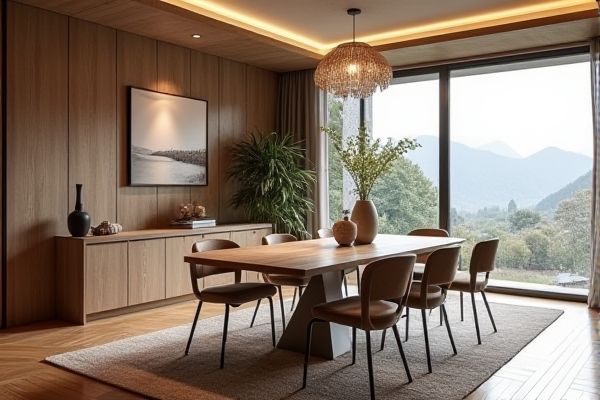
Choosing between a compact dining set and a large dining set depends on your space availability and lifestyle needs, with compact sets offering space-saving convenience and large sets providing ample seating for gatherings. Explore the rest of this article to find the perfect dining solution tailored to your home and hosting preferences.
Table of Comparison
| Feature | Compact Dining Set | Large Dining Set |
|---|---|---|
| Size | Small footprint, fits in tight spaces | Spacious, designed for large rooms |
| Seating Capacity | 2-4 seats | 6-10+ seats |
| Ideal For | Small families, apartments, studios | Large families, gatherings, formal dining |
| Design | Minimalist, space-saving | Elaborate, statement pieces |
| Cost | Affordable to mid-range | Mid to high-range |
| Material Options | Wood, metal, composite | Solid wood, metal, glass |
| Assembly | Simple, quick setup | Complex, may require professional help |
| Portability | Easy to move | Heavy, difficult to relocate |
Introduction: Choosing the Right Dining Set Size
Selecting the right dining set size depends on the available space and your lifestyle needs. Compact dining sets maximize functionality in smaller areas without sacrificing style or comfort. Your choice should balance room dimensions and seating requirements to enhance both daily meals and entertaining.
Space Efficiency: Compact vs Large Dining Sets
Compact dining sets maximize space efficiency by offering smaller dimensions that fit snugly into tight kitchens, apartments, or dining nooks without sacrificing functionality. Large dining sets provide expansive seating and surface area but require significant room, making them ideal for spacious dining rooms and entertaining multiple guests comfortably. Choosing between compact and large dining sets depends on available square footage and the need for seating capacity balanced against overall room layout and flow.
Seating Capacity and Flexibility
Compact dining sets typically offer seating for four to six people, making them ideal for small apartments or limited spaces, while large dining sets accommodate eight to twelve or more, suitable for bigger families or entertaining guests. The flexibility of compact sets allows easy rearrangement and multi-functionality in tight areas, whereas large dining sets provide more permanent, spacious dining experiences but require dedicated room. Choosing between them depends on the balance between available space, seating needs, and lifestyle preferences.
Aesthetic Appeal and Interior Design
A compact dining set offers a sleek, minimalist aesthetic ideal for small or modern interiors, maximizing space while maintaining style. Large dining sets create a bold, commanding centerpiece that enhances traditional or spacious rooms with an inviting, communal atmosphere. Your choice between the two directly impacts the flow and visual harmony of your interior design.
Functionality and Everyday Use
Compact dining sets maximize space efficiency, making them ideal for smaller kitchens or apartments with limited room, while still providing sufficient seating for daily meals. Large dining sets offer greater surface area and seating capacity, enhancing functionality for hosting gatherings and family dinners but may dominate smaller spaces. Choosing between the two depends on balancing everyday usability with space constraints and the frequency of entertaining guests.
Comfort and Room for Movement
Compact dining sets maximize comfort in smaller spaces by offering proportionate seating that allows easy movement and prevents overcrowding. Large dining sets provide ample room for comfortable seating and greater freedom of movement, ideal for gatherings and spacious dining areas. Your choice depends on balancing comfort with available space to ensure an enjoyable dining experience.
Cost Comparison: Budget Considerations
Compact dining sets generally offer a more budget-friendly option, with prices often ranging from $150 to $600, making them ideal for small spaces or affordable renovations. Large dining sets, designed for more seating and elaborate craftsmanship, typically cost between $700 and $2,500 or more, reflecting higher material quality and design complexity. Evaluating cost versus space needs ensures a balanced investment aligned with both budget constraints and functional dining requirements.
Maintenance and Cleaning
Compact dining sets generally require less maintenance and cleaning due to their smaller surface area and fewer components, making them ideal for busy households or small spaces. Large dining sets often have more intricate designs and extensive surfaces that collect dust and food particles, necessitating regular deep cleaning and upkeep. Materials used in both sets, such as wood, glass, or metal, also influence cleaning methods and frequency for maintaining their appearance and durability.
Best Use Cases for Compact Dining Sets
Compact dining sets excel in small apartments, studio spaces, or cozy kitchens where maximizing floor space is crucial. They suit individuals or small families who need functional seating without overwhelming the room. Your best use case involves creating an intimate dining area that balances comfort and space efficiency.
Ideal Scenarios for Large Dining Sets
Large dining sets are ideal for spacious homes or open floor plans where you frequently entertain guests or host family gatherings. These sets accommodate multiple people comfortably, making them perfect for holiday dinners, parties, or collaborative work environments. Your choice of a large dining set enhances both functionality and aesthetics, providing ample space without overcrowding the room.
 homyna.com
homyna.com